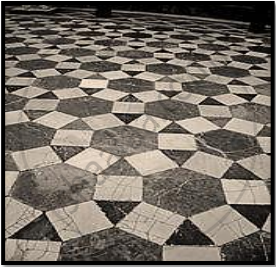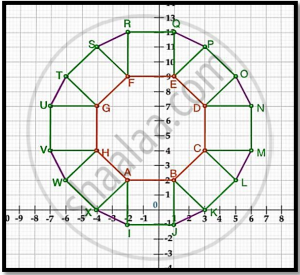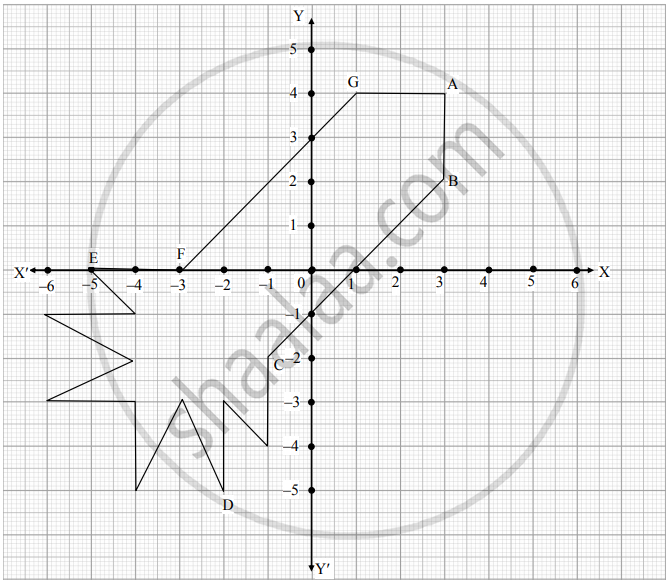Advertisements
Advertisements
Question
Name the quadrilateral formed, if any, by the following points, and given reasons for your answers:
A(4, 5) B(7, 6), C (4, 3), D(1, 2)
Solution
A (4, 5), B (7,6), C(4,3), D(1,2)
Let A, B, C and D be the four vertices of the quadrilateral ABCD.
We know the distance between two points `P(x_1,y_1)` and `Q(x_2, y_2)is given by distance formula:
`PQ = sqrt((x_2 - x_1)^2 + (y_2 - y_1)^2)`
Hence
`=> AB = sqrt((7 - 4)^2 + (6 - 5)^2)`
`=> AB = sqrt((-3)^2 + (-3)^2)`
`=> AB = sqrt(9 + 1)`
`=> AB = sqrt(10)`
Similarly,
`=> BC = sqrt((4 - 7)^2 + (3 - 6)^2)`
`=> BC = sqrt((-3)^2 + (1)^2)`
`=> BC= sqrt(9 + 9)`
`=> BC = sqrt18`
Similarly
`=> CD = sqrt((1 - 4)^2 + (2 - 3)^2)`
`=> CD = sqrt((-3)^2 + (-1)^2)`
`=> CD = sqrt(9 + 1)`
`=> CD = sqrt(9 + 1)`
`=> CD = sqrt10`
Also
`=> DA = sqrt((1 - 4)^2 + (2 -5)^2)`
`=> DA = sqrt((-3)^2 + (-3)^2)`
`=> DA = sqrt(9 + 9)`
`=> DA = sqrt18`
Hence from above we see that
AB = CD and BC = DA
Hence from above we see that
AB = CD and BC = DA
Here opposite sides of the quadrilateral is equal. Hence it is a parallelogram
APPEARS IN
RELATED QUESTIONS
Which point on the y-axis is equidistant from (2, 3) and (−4, 1)?
Prove that the points (0, 0), (5, 5) and (-5, 5) are the vertices of a right isosceles triangle.
Find a point on y-axis which is equidistant from the points (5, -2) and (-3, 2).
Find the points on the x-axis, each of which is at a distance of 10 units from the point A(11, –8).
If the point A (4,3) and B ( x,5) lies on a circle with the centre o (2,3) . Find the value of x.
Show that the points A(2,1), B(5,2), C(6,4) and D(3,3) are the angular points of a parallelogram. Is this figure a rectangle?
Points P, Q, and R in that order are dividing line segment joining A (1,6) and B(5, -2) in four equal parts. Find the coordinates of P, Q and R.
The line segment joining the points A(3,−4) and B(1,2) is trisected at the points P(p,−2) and Q `(5/3,q)`. Find the values of p and q.
Find the ratio in which the point P(m, 6) divides the join of A(-4, 3) and B(2, 8) Also, find the value of m.
If the point C(k,4) divides the join of A(2,6) and B(5,1) in the ratio 2:3 then find the value of k.
If A (1, 2) B (4, 3) and C (6, 6) are the three vertices of a parallelogram ABCD, find the coordinates of fourth vertex D.
The coordinates of the point on X-axis which are equidistant from the points (−3, 4) and (2, 5) are
If the centroid of the triangle formed by the points (a, b), (b, c) and (c, a) is at the origin, then a3 + b3 + c3 =
In which quadrant does the point (-4, -3) lie?
Find the coordinates of point A, where AB is a diameter of the circle with centre (–2, 2) and B is the point with coordinates (3, 4).
If segment AB is parallel Y-axis and coordinates of A are (1, 3), then the coordinates of B are ______
Abscissa of a point is positive in ______.
Which of the points P(0, 3), Q(1, 0), R(0, –1), S(–5, 0), T(1, 2) do not lie on the x-axis?
A tiling or tessellation of a flat surface is the covering of a plane using one or more geometric shapes, called tiles, with no overlaps and no gaps. Historically, tessellations were used in ancient Rome and in Islamic art. You may find tessellation patterns on floors, walls, paintings etc. Shown below is a tiled floor in the archaeological Museum of Seville, made using squares, triangles and hexagons.

A craftsman thought of making a floor pattern after being inspired by the above design. To ensure accuracy in his work, he made the pattern on the Cartesian plane. He used regular octagons, squares and triangles for his floor tessellation pattern

Use the above figure to answer the questions that follow:
- What is the length of the line segment joining points B and F?
- The centre ‘Z’ of the figure will be the point of intersection of the diagonals of quadrilateral WXOP. Then what are the coordinates of Z?
- What are the coordinates of the point on y-axis equidistant from A and G?
OR
What is the area of Trapezium AFGH?
Ryan, from a very young age, was fascinated by the twinkling of stars and the vastness of space. He always dreamt of becoming an astronaut one day. So, he started to sketch his own rocket designs on the graph sheet. One such design is given below :

Based on the above, answer the following questions:
i. Find the mid-point of the segment joining F and G. (1)
ii. a. What is the distance between the points A and C? (2)
OR
b. Find the coordinates of the points which divides the line segment joining the points A and B in the ratio 1 : 3 internally. (2)
iii. What are the coordinates of the point D? (1)
